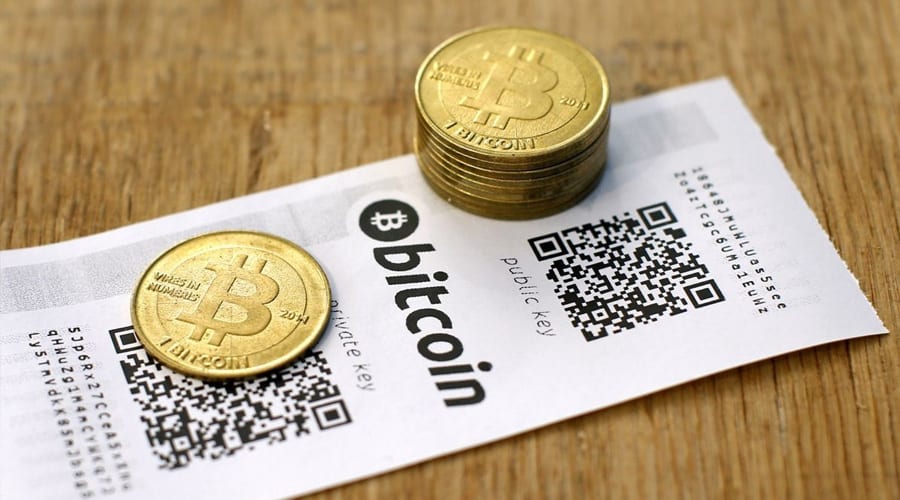The Pros and Cons of Paper Wallets for Cold Storage

The Pros and Cons of Paper Wallets for Cold Storage
When it comes to cold storage for cryptocurrencies, paper wallets are a popular choice among users seeking an offline storage method. Paper wallets involve generating a physical document that contains the public and private keys necessary for accessing and managing cryptocurrencies. In this article, we will explore the pros and cons of using paper wallets for cold storage. Understanding the advantages and disadvantages will help you make an informed decision about whether paper wallets are the right option for securely storing your digital assets.
Introduction
Cold storage is essential for safeguarding cryptocurrencies from online threats, and paper wallets offer a straightforward and offline method for storing private keys. Let’s explore the pros and cons of paper wallets as a cold storage solution.
What Is a Paper Wallet?
A paper wallet is a physical document or printout that contains the public and private keys needed to access and control cryptocurrencies. It typically includes QR codes or alphanumeric representations of the keys for easy scanning or manual input.
Pros of Paper Wallets
Using paper wallets for cold storage offers several advantages:
– Offline Security
Paper wallets provide an offline storage solution, meaning they are not connected to the internet. This isolation significantly reduces the risk of online attacks, such as hacking or malware, which are common in digital environments. As long as the paper wallet remains physically secure, the private keys are protected from digital threats.
– No Digital Vulnerabilities
Since paper wallets are not stored on digital devices, they are not susceptible to digital vulnerabilities like software bugs, viruses, or hardware failures. The absence of digital components reduces the risk of unauthorized access to the private keys through online means.
– Cost-Effective Solution
Creating a paper wallet is generally a cost-effective option. It requires only a printer, paper, and a reliable source for generating the wallet, which can often be done through reputable websites or offline software. Compared to hardware wallets or other cold storage methods, paper wallets are an affordable alternative.
Cons of Paper Wallets
While paper wallets offer certain advantages, they also have some drawbacks to consider:
– Physical Vulnerability
Paper wallets are vulnerable to physical damage, loss, or theft. The paper itself can deteriorate over time, and exposure to water, fire, or improper storage conditions can render the wallet unreadable. Safely storing paper wallets in secure and protected locations is essential to mitigate the risk of physical damage or loss.
– Lack of Convenience
Paper wallets require manual handling and manual input of the keys when making transactions. This manual process can be time-consuming and cumbersome compared to the seamless interaction provided by digital wallets or hardware wallets. Additionally, the need for physical access to the paper wallet may pose challenges if immediate transactions or quick access to funds is required.
– Single Use and Backup Challenges
Paper wallets are typically designed for single use. Once the funds associated with a paper wallet have been spent or transferred, it is considered best practice to generate a new paper wallet for future use. This creates a challenge when it comes to managing and securely backing up multiple paper wallets, as each wallet corresponds to a specific amount of cryptocurrency.
Generating a Paper Wallet
Generating a paper wallet involves several steps to ensure its security and effectiveness. Consider the following points:
- Offline Generation: It is recommended to generate the paper wallet in an offline and secure environment to minimize the risk of exposure to potential threats.
- Random Number Generation: The process of generating random numbers for the public and private keys should be done using a trusted and secure method, such as using a reliable random number generator or dice rolls.
- Printer Security: Ensure that the printer used to print the paper wallet is not compromised and free from malware or any potential security risks.
- Testing and Verification: After generating the paper wallet, it is crucial to test and verify its functionality by sending a small amount of cryptocurrency to the wallet and successfully accessing the funds.
Physical Security Measures

To mitigate the risks associated with the physical vulnerability of paper wallets, consider implementing the following security measures:
- Safe Storage: Store the paper wallet in a secure location, such as a safe or a lockbox, to protect it from theft, damage, or unauthorized access.
- Lamination or Sealing: Consider laminating the paper wallet or using a tamper-evident seal to protect it from moisture, physical wear, or tampering attempts.
- Redundant Copies: Create redundant copies of the paper wallet and store them in separate secure locations to ensure backup and recovery options in case of loss or damage to the original wallet.
Verifying Authenticity
When using a paper wallet, it is essential to verify its authenticity to ensure it hasn’t been tampered with or compromised. Consider the following steps:
- Secure Source: Use trusted and reputable sources or software to generate the paper wallet to minimize the risk of a compromised or fraudulent wallet.
- Offline Verification: Verify the public key of the paper wallet by cross-checking it with a reliable blockchain explorer or by using a separate device disconnected from the internet.
- Test Transactions: Before storing significant amounts of cryptocurrency in a paper wallet, conduct a test transaction by sending a small amount to the wallet and verifying its successful reception and access.
Transition to Hardware Wallets
While paper wallets offer an offline storage solution, some users may eventually consider transitioning to hardware wallets for added security and convenience. Consider the benefits of hardware wallets, such as:
- Enhanced Security Features: Hardware wallets offer advanced security measures, including secure elements, PIN protection, and encrypted communication, to protect private keys.
- User-Friendly Interfaces: Hardware wallets often provide intuitive interfaces, making it easier to manage multiple cryptocurrencies, initiate transactions, and securely store backups.
- Convenience and Compatibility: Hardware wallets are designed for seamless integration with various devices and software wallets, providing convenience and flexibility for cryptocurrency management.
Best Practices for Paper Wallets
To maximize the security and effectiveness of paper wallets, follow these best practices:
- Keep Private Keys Offline: Never store digital copies of private keys on connected devices or online platforms to maintain the offline nature of the paper wallet.
- Regularly Check the Wallet’s Balance: Periodically verify the balance of the paper wallet by checking it against the corresponding public key on a reliable blockchain explorer.
- Secure Destruction: If you decide to transition to a different storage method or dispose of a paper wallet, ensure its secure destruction by irreversibly destroying the paper to prevent any potential recovery of the private keys.
Limitations of Paper Wallets
While paper wallets offer offline storage for cryptocurrencies, they have certain limitations to consider:
- Lack of Accessibility: Paper wallets require physical access to the document to manage the stored cryptocurrencies. This can be challenging if immediate access or frequent transactions are needed.
- Susceptibility to Damage: Paper wallets can be susceptible to damage or degradation over time due to factors such as water, fire, insects, or physical wear. Proper storage and handling are essential to maintain the integrity of the paper wallet.
- Inconvenient Splitting of Funds: If you want to spend only a portion of the funds stored in a paper wallet, it requires transferring the remaining balance to a new paper wallet or a different storage method. This process can be cumbersome and may involve additional transaction fees.
Paper Wallet Alternatives
While paper wallets are a popular choice for cold storage, there are alternative methods available for offline cryptocurrency storage. Consider the following options:
- Hardware Wallets: Hardware wallets, as discussed earlier, offer offline storage with enhanced security features and convenient user interfaces. They provide a balance between security and usability.
- Offline Software Wallets: Offline software wallets, also known as “lite wallets,” can be installed on a computer or mobile device without requiring an internet connection. They offer a more accessible option for offline storage compared to paper wallets.
- Offline Dedicated Devices: Some devices are specifically designed for offline storage, such as offline hardware wallets or dedicated offline devices. These devices provide a secure and user-friendly way to store cryptocurrencies offline.
Balancing Security and Convenience
Choosing the right storage method involves striking a balance between security and convenience based on your individual needs. Consider the following factors:
- Amount of Cryptocurrency: The value of your cryptocurrency holdings may influence the level of security you prioritize. Higher amounts may warrant more robust security measures, such as hardware wallets, while smaller amounts may be adequately protected by paper wallets.
- Usage Frequency: Consider how frequently you need to access and transact with your cryptocurrencies. If you require regular access, hardware wallets or offline software wallets may offer a more convenient solution compared to paper wallets.
- Technical Proficiency: Different storage methods have varying levels of complexity. Paper wallets may be suitable for those who prefer a simpler and less technical approach, while hardware wallets require more technical proficiency for setup and usage.
Regular Security Audits and Updates
To ensure the continued security of your chosen cold storage method, it is essential to stay updated with security audits and follow recommended security practices. Consider the following:
- Stay Informed: Keep track of security news, updates, and best practices related to your chosen storage method. Subscribe to official channels, forums, or communities to receive the latest information.
- Firmware or Software Updates: Regularly check for firmware or software updates provided by the manufacturers or developers of your chosen storage method. These updates often include bug fixes and security enhancements.
- Independent Reviews: Read independent reviews and assessments of the security features and vulnerabilities associated with your chosen storage method. This will help you stay informed about potential risks and make informed decisions.
Conclusion
Paper wallets offer an offline and cost-effective solution for cold storage of cryptocurrencies. Their offline security and lack of digital vulnerabilities make them an appealing option for those seeking a simple and affordable cold storage method. However, paper wallets are not without their drawbacks. The physical vulnerability, lack of convenience, and challenges associated with single use and backup management should be carefully considered. Ultimately, the decision to use paper wallets as a cold storage solution depends on individual preferences and the level of security and convenience desired for managing cryptocurrencies.







